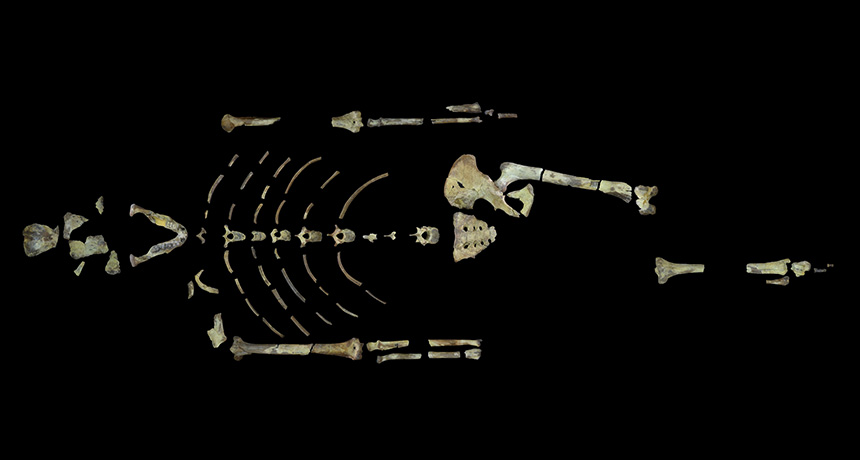Buff upper arms let Lucy climb trees
Arm, leg bone X-ray data provide clues to famous hominid’s mobility

ARM STRONG Relatively long, robustly built upper arms let Lucy, the famous 3.2-million-year-old hominid, spend a lot of time in trees, scientists say. Scans of Lucy’s fossils also suggest she walked less efficiently than people today do.
J. Kappelman/Univ. of Texas at Austin
Lucy didn’t let an upright stance ground her. This 3.2-million-year-old Australopithecus afarensis, hominid evolution’s best-known fossil individual, strong-armed her way up trees, a new study finds.
Her lower body was built for walking. But exceptional upper-body strength, approaching that of chimpanzees, enabled Lucy to hoist herself into trees or onto tree branches, paleoanthropologist Christopher Ruff of Johns Hopkins University School of Medicine and his colleagues report November 30 in PLOS ONE.
Lucy, and presumably other members of her species, “combined walking on two legs with a significant amount of tree climbing,” says coauthor John Kappelman, a paleoanthropologist at the University of Texas at Austin. A Kappelman-led team concluded earlier this year that, based on numerous bone breaks, Lucy fell to her death from a tree, either while climbing or sleeping (SN: 9/17/16, p. 16). That’s a controversial claim, dismissed by some researchers as a misreading of bone damage caused by the fossilization process.
Debate about whether A. afarensis spent much time in trees goes back to shortly after the discovery of Lucy’s partial skeleton in 1974. Additional discoveries of A. afarensis fossils have only intensified disputes between those who regard the ancient species as primarily designed for walking and others convinced that Lucy’s crowd split time between walking and tree climbing (SN: 12/1/12, p. 16; SN: 7/17/10, p. 5).
Ruff’s team measured the internal structure and strength of Lucy’s two surviving upper arm bones and one upper leg bone, including the knob at the top of the upper leg that forms the hip joint. Data came from high-resolution X-ray CT scans taken in 2008 while her remains were in the United States for a museum tour.
These scans were compared with those of present-day people, chimps and bonobos, as well as 26 fossil hominids. These hominids — including both australopithecines like Lucy, as well as early members of the human genus, Homo — date to between 2.6 million and 600,000 years ago.
Lucy’s long, weight-bearing upper arms most closely resemble the anatomy of chimps, the scientists say. Studies of various living animals, including humans and chimps, indicate that daily behaviors during growth influence the development of limb bones. Thus, it’s plausible that Lucy pulled herself into trees from an early age, adding to the strength and length of her upper arms, the team proposes.
Although Lucy walked upright, she had a less efficient gait than that of people today and Homo erectus individuals dating to between 1.6 million and 700,000 years ago, the researchers say. The stress of supporting a robust upper body with a slighter lower body would have interfered with Lucy’s two-legged stride, they hold. Traits such as a relatively small hip joint and short legs limited Lucy’s ability to walk long distances, the investigators add.
Ruff’s study supports proposals over the last few decades that, for her size, Lucy had longer, stronger arms and smaller hip joints than people now do, says paleoanthropologist Carol Ward of the University of Missouri School of Medicine in Columbia. It’s plausible that a small hip joint slightly undermined Lucy’s stride, but that hasn’t been conclusively demonstrated, Ward adds.
Biological anthropologist Philip Reno of Penn State takes a harder line. “This new analysis does not resolve any of the debates regarding the use of tree climbing or the effectiveness of upright walking in australopithecines.” Radical, humanlike changes to the pelvis and foot in Lucy’s species suggest that her large upper arms were simply evolutionary holdovers from hominids’ tree-dwelling ancestors, not the consequences of extensive tree climbing, Reno argues. It’s hard to say how Lucy’s relatively small hip joint interacted with many other skeletal and muscular forces affecting an upright gait, he adds.
The big question, in Ward’s view, is whether skeletal changes in early Homo conducive to walking and running arose as a result of largely abandoning tree climbing or for other reasons, such as an increasing emphasis on arms and hands capable of manipulating objects in precise ways.







